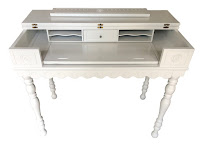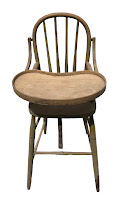 |
| Rockers Before Restoration |
 |
| Rockers After Restoration |
Twin chairs! This was definitely a first for us, having two identical rocking chairs to refinish at the same time. The most surprising feature of these chairs was the size. Each chair weighed in at 60-70 lbs., possibly more. This required both of us to unload them from the customer’s van and bring them into our work space.
Having chairs such as these as heavy as they were, made working on them quite challenging. They were not only heavy, they were huge! We have a large rocking chair in our living room with a similar style, but ours isn’t nearly as heavy as these were, nor is it as tall as these were.
The keyhole cutout design in the back center of each chair was a unique feature that gave them personality, adding a nice detail. The front of the chairs’ seat had a very rounded and thickness that I could hardly wrap my hand around. Yes, definitely massive. One of the chairs had suffered dog chew damage on the lower right leg spindle. The chairs had been repaired by someone else for the damage prior to us doing the refinishing.
The chairs were both fairly worn and really cried out to be stripped, sanded and stained. This process was very time-consuming due to the sheer size of these mammoths and the detail, mainly the spindles, which if you’ve read other articles in our blog you know that they require a great deal of time and attention to remove all that old finish. We use work carving tools which allow us to get into the nitty-gritty of the spindles’ curves and tight spot. You’d be surprised at how much stain there is on any item of furniture even though it may look worn. There’s still a lot to remove. And that takes time. There’s simply no getting around that part of this work.
When the chairs were all stripped and sanded, Jim used English Chestnut stain, followed by three coats of polyurethane which will protect them for years to come. Refinishing really shows off the gorgeous woodgrain that was unseen prior to refinishing. That’s the beauty of a full refinish. You can see the woodgrain that is normally not as visible when furniture comes from the factory. Their process is different from hand finishing, therefore has a different look.
If you've ever wondered if that special piece of furniture you’ve held onto for many years because you don’t know if it’s worth restoring, take a look at the wood. More times than not, once it is stripped, it is better than new because the hand stripping process restores it to its original beauty that was likely not seen when done on the assembly line. The value is already there so refinishing is always worth it. Unless a piece really is made cheaply and has no sentimental value, having it restored/refinished is a great way to preserve a piece of your family’s history or create a new family heirloom for future generations.




























